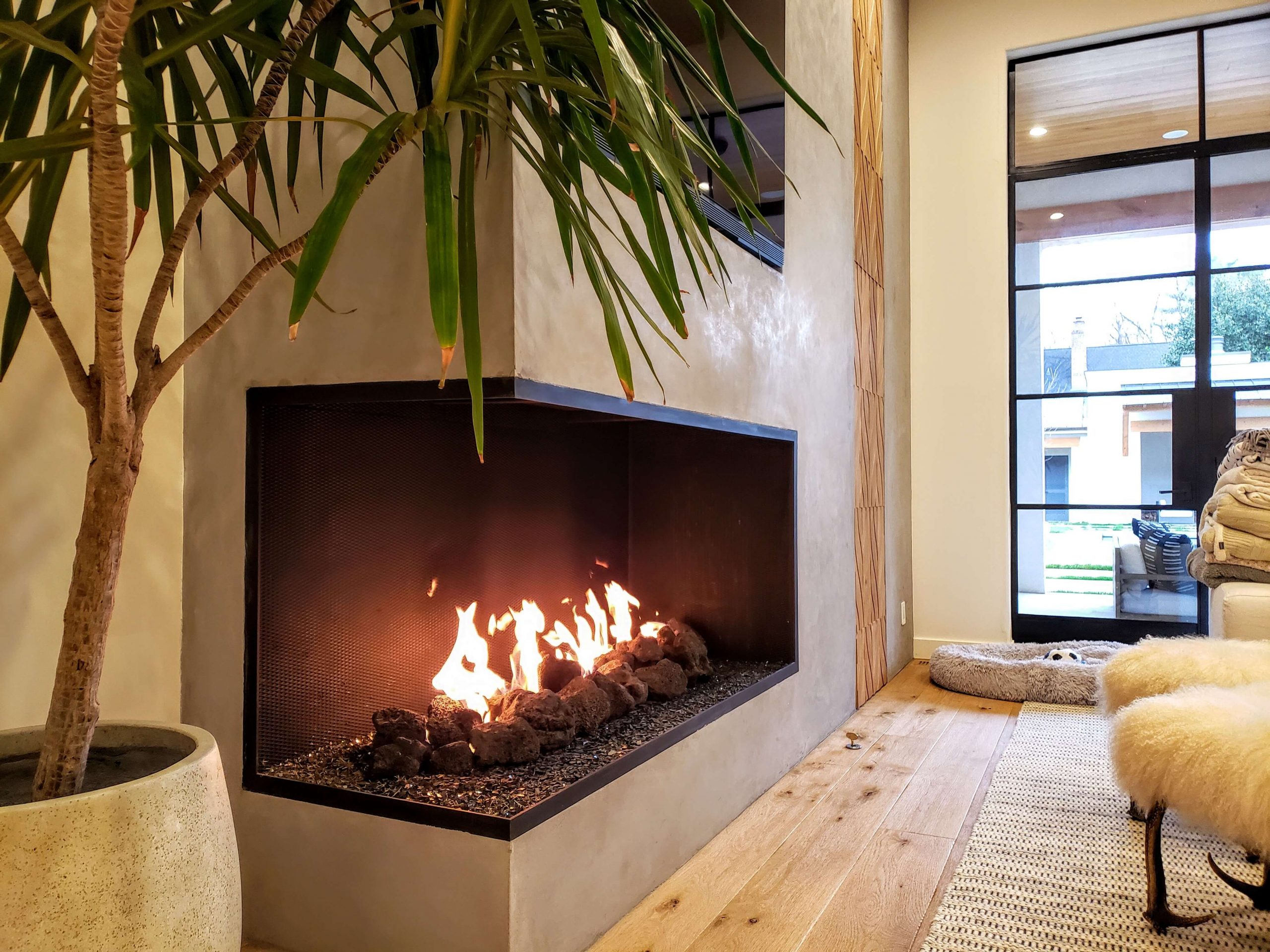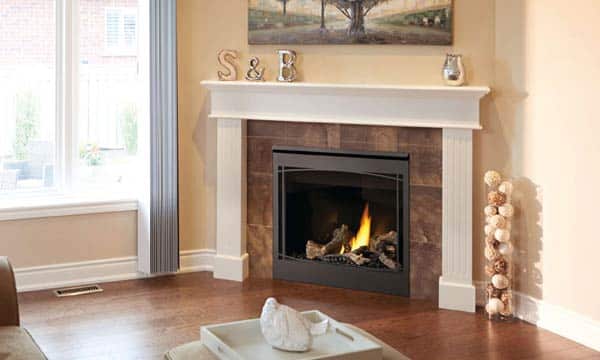A gas fireplace is a great addition to any home renovation. If you are investing in a gas fireplace, one of the major concerns for you is the right type of venting system. The safety consideration related to the gas fireplace is something that can not be avoided.
If your home has a traditional chimney, the first option you see is to use it as a chimney. But is it effective for a gas fireplace as well, with the same efficiency? If you do not have one, one major concern is do gas fireplaces need a chimney. Let us face it: installation of a chimney can be very expensive.
If you are not sure whether your gas fireplace needs a chimney or not and are closely inspecting the alternatives, you have reached the right place. Do gas fireplaces need a chimney? Let us closely analyze the answer in this blog!
What is a Gas Fireplace?

With a gas fireplace, you get both efficiency and the aesthetics of the burning wood without actually being a wood-burning fireplace. Unlike a typical wood-burning fireplace, a gas fireplace has logs that don’t actually burn. The logs have gas vents that release gas that is combustible and acts as the fuel mimicking real and wood-burning fire.
The heat using a gas fireplace is instant, unlike a typical fireplace where the fire takes time to set up. With the controls, you can manage the temperature and have a quick setup with the gas fireplaces. The fireplaces with this technology are also more efficient.
The Role of Chimneys in Typical Fireplaces

If you have a fireplace at your home, you probably enjoy its warmth in cold winters. But as the combustion proceeds, the result is the formation of smoke and some other gases which are harmful to us. Note that we are considering the traditional fireplaces. Using a pressure difference built by hot and cold air together, the smoke from the fireplace is evacuated.
Gas fireplaces do not necessarily require a chimney to function efficiently, but it is important to remove the toxic fumes and gases that build up as the gas fireplaces are used. So, for your question, do gas fireplaces need a chimney or not? The answer is that gas fireplaces will require a ventilation system depending on what type of gas fireplace it is. So, before proceeding with the question of whether gas fireplaces need a chimney or not, let us begin with understanding the types of gas fireplaces.
Types of Gas Fireplaces
To begin with this, let us first clear one question that is very common with gas fireplaces. A chimney aims to draw out the air that is a product of the gas fireplaces. But other gas appliances in our homes require no chimney or a dedicated venting system. Can this be the same for a gas fireplace? The requirement of a ventilation system for a gas fireplace will depend on what type of gas fireplace you own.
Let us briefly understand the three most common types of gas fireplaces.
1. Standard Gas Stove

If your home has an installed standard gas stove, then a chimney is not something you can miss. A flue is one alternative you can use as a ventilation system for the standard gas stove. Unlike a wood fireplace, the standard gas stove will not necessitate the use of class 1 bricks as you build a chimney. Class 2 prefabricated chimney suits the best. The details about the diameter and size of the chimney are given by the manufacturers.
2. Balanced Flue Gas Fireplaces

If your preference is not a chimney as a ventilation system, a balanced flue gas fireplace is an alternative for you to try. The flue gas fireplaces eliminate the need for a chimney but will ventilate by installing a balanced flue.
3. Gas Stoves Without Flue

There are a lot of gas fireplaces that require no chimney or a flue. The working of these gas stoves is based on the conversion of toxic fumes and gases into safe ones, which are then sent back to the room, unlike a chimney or flue ventilation. The requirements for such fireplaces will be specified by the manufacturers that you must strongly adhere to.
4. Gas Fireplaces with a Chimney

A chimney is not a necessity with the other venting options available. If that is what you choose to go with, then an installed chimney in your home should do just fine. If you are opting for a chimney, here are some of the things to consider for efficient ventilation:
Choose the size of your chimney appropriately. It should be big enough to vent out the toxic residues from the gas fireplace. The size should coordinate with the size of your gas fireplace to ensure the ventilation is effective.
Cleaning the chimney is crucial, and you can not miss it. One problem with chimneys is the building up of condensation, which is highly flammable. Schedule regular cleaning and maintenance routines for your chimney.
Cleaning a Gas Fireplace Chimney

- A major concern with wood-burning fireplaces is the buildup of soot and creosote. Unlike the problem of creosote buildup in wood-burning fireplaces, gas fireplaces pose a threat of deposition of corrosive substances that could damage your chimney.
- Draft in fireplaces is the driving force that evacuates toxic gases and provides air for combustion. If your chimney is not maintained ideally, a change in the draft will not only hinder the expulsion of the released products. Still, it will also reduce the availability of air, causing the production of carbon monoxide.
- Adding to that, the modern designs for chimneys have no extra heat that is required to prevent condensation of water vapors, causing them to condense. Being highly acidic and corrosive, they can be harmful to your chimneys.
Limitations of Chimneys in Gas Fireplaces

Do gas fireplaces need a chimney? Can chimneys be the best option for gas fireplaces? If you have similar questions, let us understand why traditional chimneys, especially chimneys meant for wood-burning fire, are sometimes a failure for gas fireplaces. Chimneys meant for wood-burning fires are designed in a way that generates a strong draft. With gas fireplaces, the heat and by-products are both produced in relatively lesser quantities, causing weaker drafts and poor ventilation.
Additionally, a chimney meant for wood-burning fireplaces is designed to endure hotter and drier conditions. As a result, there are chances of an increase in moisture, increasing the chances of mold growth and damage. Additionally, the by-products of gas fireplaces being acidic can increase the chances of corrosion and rust. It will be a mistake to forget about the high costs of installing new chimneys that have safety compliance with the gas fireplaces.
Installing a Gas Fireplace without a Chimney

- If you are confused about whether gas fireplaces need a chimney or not, the answer is no. Additionally, if your house doesn’t already have a chimney, it can cost you a lot to build a new chimney. The requirement of professional experts, labor costs, and materials make it an expensive addition to your home.
- Do you have a pre-installed chimney at your home? If yes, it is best to use it for venting. If not, installing a pipe to do the same is one option you have. The pipes that funnel out the toxic fumes can be placed either vertically or horizontally. Ventless gas fireplaces are another alternative that eliminates the need for a chimney.
- If you do not have a chimney or any other type of vent, your gas fireplaces will work as fine as it would without its presence. The only function vents or chimneys serve to expel the toxic fumes and harmful products after the fireplaces are used, without affecting their working or efficiency. So, a gas fireplace needs no chimney as long as you install another ventilation system for the gas fireplace. If you want to eliminate the requirement of a chimney or other ventilation systems, there are options for some of the ventless models ready to serve you.
- Ventilation is crucial to remove the fumes produced as the end products when fireplaces are used. Apart from a chimney, there are two options for gas fireplaces, i.e., a vented or a ventless fireplace. Both of the options are excellent if you are looking for a replacement for your chimney. If you are unsure what will work best for your home, here is a brief introduction to both alternatives.
Direct Vent Gas Fireplaces

Direct venting, an efficient and flexible method of venting, is one of the most popular venting options people prefer. The direct vent fireplaces take in combustible air from the room itself and give out heated air. A section of the same vent system expels out the toxic fumes that are produced with ignition in the fireplace. The safety and efficiency of the vent system make it an ideal replacement for chimneys for your gas fireplaces. Gas fireplaces with this system come in different sizes, so direct vent offers versatility and flexibility for the fireplaces.
Direct vent gas fireplaces have a few advantages over a chimney as a vent. The energy efficiency of these fireplaces is relatively higher, with less heat loss. Lower maintenance costs and an environment-friendly solution are two other reasons homeowners love it. One drawback of such systems is that the gas used for combustion can be a bit expensive.
Ventless Gas Fireplaces

- If you still struggle with the question, do gas fireplaces need a chimney, or what are the best alternatives with no vent? Here is another variation of gas fireplaces for you that completely eliminates the need for a vent. Missing an exhaust system, this system will not require both a chimney or a piping vent system. The pollutants released by the burning fireplaces remain in the same place rather than being expelled from the room.
- With ventless gas fireplaces, the companies equip oxygen sensors, which shut the fireplaces off when the levels fall too low. Ventless gas fireplaces have multiple benefits, like convenience and high energy efficiency. The ventless gas fireplace also avoids the risk of energy wastage by leakage or because of drafts like in vented fireplaces. Without a need for chimneys and vent systems, the ventless fireplaces offer versatility in design.
- Among the benefits of ventless gas fireplaces, there are a few major concerns that pose a challenge to adaptability to these fireplaces. Depletion of oxygen in the room and buildup of carbon monoxide are two major concerns why people do not prefer this type of gas vent fireplace. Most of these fireplaces are meant to burn fuel with no emitted toxic substances, but they still can emit a few pollutants. Additionally, it can cause a buildup of moisture, humidity, and odors.
Safety Tips for Venting Systems of Gas Fireplaces
- Before installing the gas fireplace and choosing the type of vent for it, educate yourself on the topic. Learn the basics about it so that you make informed decisions and can choose the right venting system for your gas fireplace.
- Gas fireplaces can be a hazard if not done in the right way. Seek professional guidance and services for the installation of gas fireplaces with the vent system for your home to make the experience seamless.
- If your home has a chimney as the vent, chimney care is something you can miss. It will require maintenance, regular cleaning, and often checking for damage or leaks.
- Regular cleaning of the fireplaces along with the attached venting is a must not only for the durability of fireplaces but also to prevent any mishap. Regular cleaning of the fireplaces ensures the standards of the fireplaces are met.
- Gas log care is utterly important in gas fireplaces. Both the vented and ventless designs require regular maintenance. The maintenance is minimal, so it is something that can be easily done.
- Whether you choose a vented or ventless gas fireplace, it is important for you to know all the requirements for your fireplace. Learning the specifics will help you to maintain safety compliance with your gas fireplace.
- It is wise to install detectors with gas fireplaces. Although the gas fireplaces are efficient, you never know when it can malfunction. Some of the important detectors that should be installed are carbon monoxide detectors, smoke detectors, oxygen level detectors, and gas leak detectors.
Wrapping Up
A gas fireplace utilizes gas as fuel instead of wood, making it an efficient alternative to wood-burning fireplace. If you are planning to install a gas fireplace, one question you will find yourself asking is, do gas fireplaces need a chimney?
The answer to it depends on what vent system you prefer for your home. Each type of vent system has its pros and cons. A chimney can be a great option if you already have it in your home. Otherwise, it is an expensive addition to your home.
Vented and ventless gas fireplaces can be an efficient and versatile option for your home. While there’s no perfect vent system, learn about it beforehand to make an informed decision.
Comment down if you have any questions for us to answer!








